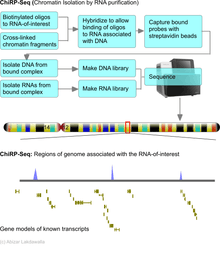ChiRP-Seq
ChiRP-Seq (Chromatin Isolation by RNA purification) is a high-throughput sequencing method to discover regions of the genome which are bound by a specific RNA (or a by a ribonucleoprotein containing the RNA of interest). Recent studies have shown that a significant proportion of some genomes (including mouse and human genomes) synthesize RNA that apparently do not code for proteins. The function of most of these non-coding RNA still has to be ascertained. Various genomic methods are being developed to map the functional association of these novel RNA to distinct regions of the genome to gain a better understanding of their function. ChiRP-Seq is one of these new methods which uses the massively parallel sequencing capability of 2nd generation sequencers to catalog the binding sites of these novel RNA molecules on a genome.
Overview of ChiRP-Seq method: Tens of oligonucleotide probes are designed to be complementary to the RNA of interest. These oligos are labeled with biotin. Cells are cross-linked by UV or formalin and nuclei are isolated from these treated cells. The isolated nuclei were lysed and the released chromatin was fragmented by sonication to produce approximately 100-500 bp sized fragments. These chromatin fragments were hybridized to the biotinylated probe set. Complexes containing biotin-probe + RNA of interest + DNA fragment are captured by magnetic beads labeled with streptavidin.

DNA is isolated from an aliquot of the bound complex by treatment with RNAse (or proteinase followed by RNAse) to digest associated protein and RNA. RNA may also be isolated from an additional aliquot of the bound complex to detect other RNA molecules associated with the RNA of interest. The purified DNA is then used to prepare a sequencing library and the library is sequenced on a next generation DNA sequencing system. The sequencing reads are then mapped to the genome. A pile-up of reads at specific locations on the genome indicates that the RNA of interest had bound to that region of the genome. This helps delineate specific genomic regions that interact with RNA. For example, genomic targets of enhancer RNA which act at a distance from their site of synthesis can be easily evaluated by ChiRP-Seq. [1] [2]
References
- ↑ Chu, Ci; Qu, Kun; Zhong, Franklin L.; Artandi, Steven E.; Chang, Howard Y. (31 August 2011). "Genomic Maps of Long Noncoding RNA Occupancy Reveal Principles of RNA-Chromatin Interactions". Molecular Cell. doi:10.1016/j.molcel.2011.08.027.
- ↑ Li W., Notani D., Ma Q., Tanasa B., Nunez E., et al. (2013) Functional roles of enhancer RNAs for oestrogen-dependent transcriptional activation. Nature 498: 516-520